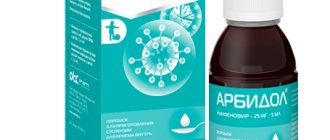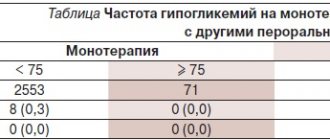Allapinin 25 mg 30 pcs. pills
pharmachologic effect
Antiarrhythmic drug.
Composition and release form Allapinin 25 mg 30 pcs. pills
Tablets - 1 tablet:
- Active substance: Lappaconitine hydrobromide with accompanying alkaloids (Allapinin®) (calculated as 100% substance) - 0.025 g; Lappaconitine hydrobromide with accompanying alkaloids (Lappaconitine hydrobromide) (calculated as 100% substance) - 0.025 g;
- Excipients: Sucrose (sugar), or refined sugar, or granulated sugar - 0.0655 g; Potato starch (extra grade) - 0.0075 g; Calcium stearate - 0.001 g; Croscarmellose sodium - 0.001 g; Tablet weight - 0.1 g.
Tablets, 25 mg.
10 or 30 tablets in a blister pack made of polyvinyl chloride film and printed varnished aluminum foil.
One, two, three or five blister packs No. 10 or one blister pack No. 30, together with instructions for medical use, are placed in a cardboard pack for consumer packaging.
Description of the dosage form
The tablets are round, biconvex, white.
Directions for use and doses
Inside, after eating, with a small amount of water at room temperature, do not crush.
Take 1 tablet (25 mg) every 8 hours, if there is no therapeutic effect - every 6 hours.
It is possible to increase the single dose to 2 tablets (50 mg) every 6-8 hours. The maximum daily dose is 300 mg (12 tablets).
The duration of treatment and correction of the dosage regimen (increasing the dose) is determined by the doctor.
Pharmacodynamics
Pharmacological properties
Allapinin® is a hydrobromic salt of the alkaloid lappaconitine with accompanying alkaloids, obtained from the grass of the white-mouthed fighter - Aconitum leucostomum Worosch. and rhizomes with roots of the northern fighter (high fighter) Aconitum septentrionale Koelle (A. excelsum Reichenb.), fam. Ranunculaceae - Ranunculaceae.
Pharmacodynamics
Class IC antiarrhythmic drug.
Blocks “fast” sodium channels of cardiomyocyte membranes. Causes a slowdown in atrioventricular (AV) and intraventricular conduction, shortens the effective and functional refractory periods of the atria, AV node, His bundle and Purkinje fibers, does not affect the duration of the QT interval, conduction through the AV node in the anterograde direction, heart rate (HR) and blood pressure (BP), myocardial contractility (in the initial absence of symptoms of heart failure). It does not inhibit the automatism of the sinus node, does not have a negative inotropic effect, and does not have an antihypertensive or m-cholinolytic effect.
It has a moderate antispasmodic, coronary dilation, local anesthetic and sedative effect.
When taken orally, the effect develops after 40-60 minutes, reaches a maximum after 4-5 hours and lasts 8 hours or more.
Pharmacokinetics
When taken orally, lappaconitine hydrobromide is rapidly absorbed from the gastrointestinal tract, the maximum concentration in the blood plasma is achieved on average after 80 minutes. The bioavailability of lappaconitine hydrobromide is 56%, which is associated with the effect of “first pass” through the liver. The main pharmacologically active metabolite is desacetyllappaconitine. The half-life (T1/2) is 1.2-2.4 hours. With prolonged oral use, an increase in T1/2 is possible.
In chronic renal failure, T1/2 increases 2-3 times, in liver cirrhosis - 3-10 times.
In chronic heart failure of functional class II-III according to the NYHA classification, the absorption of lappaconitine hydrobromide is slow (the maximum concentration in the blood plasma is reached after 2 hours). It is excreted by the kidneys in a modified form (up to 28%), the rest through the intestines.
Indications for use Allapinin 25 mg 30 pcs. pills
Supraventricular and ventricular extrasystole, paroxysms of atrial fibrillation and flutter; paroxysmal supraventricular tachycardia, including in Wolff-Parkinson-White syndrome (WPW), paroxysmal ventricular tachycardia (in the absence of organic changes in the myocardium).
Contraindications
Hypersensitivity to the drug, sinoatrial block, AV block II and III degrees (without an artificial pacemaker), cardiogenic shock, right bundle branch block combined with blockade of one of the branches of the left leg, severe arterial hypotension (systolic blood pressure less than 90 mm Hg. Art.), moderate and severe chronic heart failure of functional class III-IV according to the NYHA classification, severe hypertrophy of the left ventricular myocardium (≥1.4 cm), the presence of post-infarction cardiosclerosis, severe dysfunction of the liver and/or kidneys, age under 18 years ( efficacy and safety have not been established), fructose intolerance and glucose/galactose malabsorption syndrome or sucrase/isomaltase deficiency (the drug contains sucrose).
Use with caution in case of 1st degree AV block, intraventricular conduction disorder, sick sinus syndrome (SSNS), bradycardia, severe severe peripheral circulatory disorders, angle-closure glaucoma, benign prostatic hypertrophy, conduction disorder along Purkinje fibers, blockade of one of the bundle branches, disturbances of water and electrolyte metabolism (hypokalemia, hyperkalemia, hypomagnesemia), simultaneous use of other antiarrhythmic drugs
Application Allapinin 25 mg 30 pcs. pills during pregnancy and breastfeeding
The use of Allapinin® during pregnancy is not recommended. The use of the drug is possible only for vital indications, if the expected benefit to the mother outweighs the potential risk to the fetus/child.
There is no data on the excretion of lappaconitine hydrobromide into breast milk. The use of the drug is not recommended during breastfeeding. If use of the drug during lactation is necessary, breastfeeding should be discontinued.
special instructions
Before starting to use the drug Allapinin®, it is necessary to eliminate disturbances in water-electrolyte metabolism; during therapy, monitoring of the water-electrolyte balance of the blood is necessary.
In patients who have suffered an acute myocardial infarction or in patients with heart failure, as well as in patients with an installed artificial cardiac pacemaker, the pacemaker threshold may increase.
If headache, dizziness, or diplopia develop, the dose of Allapinin® should be reduced.
If sinus tachycardia occurs during long-term use of the drug, the use of beta-blockers (low doses) is indicated.
1 tablet of Allapinin® contains 0.074 g of carbohydrates, which corresponds to 0.01 XE (bread units).
Impact on the ability to drive vehicles and operate machinery
When using the drug, care should be taken when performing potentially hazardous activities that require special attention and quick reactions (driving vehicles, working with moving mechanisms).
Overdose
Symptoms: has a small therapeutic breadth, so severe intoxication can easily occur (especially with simultaneous use of other antiarrhythmic drugs): prolongation of PR and QT intervals, expansion of the QRS complex, increase in the amplitude of T waves, bradycardia, sinoatrial and AV block, asystole, paroxysms of polymorphic ventricular tachycardia, decreased myocardial contractility, marked decrease in blood pressure; dizziness, blurred vision, headache, gastrointestinal disorders.
Treatment: symptomatic; do not use class IA or IC antiarrhythmic drugs for the treatment of ventricular tachycardia; sodium bicarbonate can eliminate widening of the QRS complex, bradycardia and arterial hypotension.
Side effects Allapinin 25 mg 30 pcs. pills
When using the drug, dizziness, headache, a feeling of heaviness in the head, skin hyperemia, ataxia, diplopia, allergic reactions are possible, intraventricular and AV conduction disturbances, sinus tachycardia (with long-term use), arrhythmogenic effects are possible.
ECG changes: prolongation of the PQ interval, expansion of the QRS complex.
Drug interactions
Inducers of microsomal liver enzymes reduce the effectiveness and increase the risk of developing toxic effects of lappaconitine hydrobromide.
With simultaneous use of lappaconitine hydrobromide with other antiarrhythmic drugs, the risk of developing arrhythmogenic effects increases.
Lappaconitine hydrobromide enhances the effect of non-depolarizing muscle relaxants.
Allapinin tablet 25 mg cor x30
MINISTRY OF HEALTH OF THE RUSSIAN FEDERATION
,
INSTRUCTIONS
on medical use of a medicinal product
ALLAPININ®
, Registration number: P N000405/02 Trade name: Allapinin®, International nonproprietary or generic name: Lappaconitine hydrobromide Dosage form: tablets. Composition (per tablet)
Active ingredient: Lappaconitine hydrobromide with accompanying alkaloids (Allapinin®) (in terms of 100% substance) or Lappaconitine hydrobromide with accompanying alkaloids (Lappaconitine hydrobromide) (in terms of 100% substance) – 25 mg
Excipients: sucrose (white sugar), potato starch, calcium stearate, croscarmellose sodium. , , , , , , , , , , , , , , ,
Description , , , , , , , , ,
The tablets are round, biconvex, white.
Pharmacotherapeutic group: antiarrhythmic drug.
ATX code: C01BG.
Pharmacological properties
Allapinin® is a hydrobromic salt of the alkaloid lappaconitine with accompanying alkaloids, obtained from the grass of the white-mouthed fighter - Aconitum leucostomum Worosch. and rhizomes with roots of the northern fighter (high fighter) – Aconitum septentrionale Koelle (A. excelsum Reichenb.), fam. Ranunculaceae – Ranunculaceae.
Pharmacodynamics
Class IC antiarrhythmic drug.
Blocks “fast” sodium channels of cardiomyocyte membranes. Causes a slowdown in atrioventricular (AV) and intraventricular conduction, shortens the effective and functional refractory periods of the atria, AV node, His bundle and Purkinje fibers, does not affect the duration of the QT interval, conduction through the AV node in the anterograde direction, heart rate (HR), contractility myocardium (in the initial absence of symptoms of heart failure). It does not inhibit the automatism of the sinus node, does not have a negative inotropic effect, and does not have an antihypertensive or anticholinergic effect.
It has a moderate antispasmodic, coronary dilation, local anesthetic and sedative effect.
When taken orally, the effect develops after 40-60 minutes, reaches a maximum after 4-5 hours and lasts 8 hours or more.
Pharmacokinetics
When taking the drug Allapinin® orally, lappaconitine hydrobromide is quickly absorbed in the gastrointestinal tract, the maximum concentration in the blood plasma is reached on average after 80 minutes, after which it quickly decreases. Penetrates the blood-brain barrier. The half-life (T1/2) is 1.17-2.4 hours. About 10% of lappaconitine hydrobromide is excreted by the kidneys per day. The bioavailability of lappaconitine hydrobromide ranges from 40 to 56%, which is associated with the “first pass” effect through the liver. Distribution volume 690 l. Among the metabolites formed, the main pharmacologically active metabolite is desacetyllappaconitine. In chronic heart failure of functional class III-IV according to the NYHA classification, the absorption of lappaconitine hydrobromide is slowed down (the maximum concentration in the blood plasma is reached after 2 hours), and the role of renal excretion increases (up to 28% of lappaconitine hydrobromide is excreted by the kidneys per day).
, Indications for use
Supraventricular and ventricular extrasystole, paroxysmal form of fibrillation and flutter, atrial fibrillation, paroxysmal supraventricular tachycardia, including with Wolff-Parkinson-White syndrome (WPW), paroxysmal ventricular tachycardia (in the absence of organic changes in the myocardium).
, Contraindications Hypersensitivity to lappaconitine hydrobromide or to any other component of the drug, sinoatrial block, AV block of the second and third degree (without pacemaker), cardiogenic shock, right bundle branch block combined with blockade of one of the branches of the left leg, severe arterial hypotension ( systolic blood pressure less than 90 mm Hg), moderate and severe chronic heart failure of functional class III-IV according to the NYHA classification, severe left ventricular myocardial hypertrophy (≥1.4 cm), post-infarction cardiosclerosis, Brugada syndrome, acute myocardial infarction, severe impaired liver and/or kidney function, age under 18 years (efficacy and safety have not been established), fructose intolerance and glucose/galactose malabsorption syndrome or sucrase/isomaltase deficiency (the drug contains white sugar).
,
Use with caution in patients with a pacemaker, AV block I degree, chronic heart failure, functional class I-II according to the NYHA classification, intraventricular conduction disorders, sick sinus syndrome (SSNS), bradycardia, severe peripheral circulatory disorders, angle-closure glaucoma, benign hypertrophy prostate gland, impaired conduction along Purkinje fibers, blockade of one of the branches of the His bundle, impaired water and electrolyte metabolism (hypokalemia, hyperkalemia, hypomagnesemia), while taking other antiarrhythmic drugs.
,
Use during pregnancy and breastfeeding
The use of the drug during pregnancy is not recommended due to the lack of controlled studies.
Animal studies have shown that lappaconitine hydrobromide in doses of 1-5 mg/kg does not have teratogenic or embryotoxic effects.
The effect on fertility has not been studied.
It is possible to use the drug only for health reasons if the expected benefit to the mother outweighs the potential risk of side effects in the fetus/child.
There are no data on the excretion of lappaconitine hydrobromide into breast milk. The use of the drug is not recommended during breastfeeding.
If the use of Allapinin® during lactation is necessary, breastfeeding should be discontinued.
, Method of administration and dosage: Orally, after meals, with a small amount of water at room temperature, do not crush.
Take 1 tablet (25 mg) every 8 hours, if there is no therapeutic effect, every 6 hours.
It is possible to increase the single dose to 2 tablets (50 mg) every 6-8 hours.
The duration of treatment and correction of the dosage regimen (increasing the dose) is determined by the doctor.
The highest single dose is 50 mg (2 tablets), daily dose is 300 mg (12 tablets).
,
Side effect
According to the World Health Organization, adverse effects are classified according to their frequency as follows: very common (≥10% of prescriptions), common (≥1% and <.10%), uncommon (≥0.1% and <.1% ), rare (≥0.01% and <.0.1%), very rare (<.01%), frequency unknown (insufficient data to estimate the frequency of development).
Nervous system disorders
very often: dizziness, headache, feeling of heaviness in the head, ataxia,
Skin and subcutaneous tissue disorders
often: allergic reactions (skin hyperemia, skin itching),
Visual disorders
very common: diplopia
Heart disorders
very often: intraventricular and AV conduction disorders,
often: sinus tachycardia (with prolonged use), increased blood pressure,
uncommon: arrhythmogenic effect.
Laboratory and instrumental data
Very often: ECG changes: prolongation of the PQ interval, expansion of the QRS complex.
If you experience side effects listed in the instructions or they get worse, or you notice any other side effects not listed in the instructions, tell your doctor.
,
Overdose
The drug has a small therapeutic breadth, so severe intoxication can easily occur (especially with simultaneous use of other antiarrhythmic drugs).
Symptoms: prolongation of PR and QT intervals, expansion of the QRS complex, increased amplitude of T waves, bradycardia, sinoatrial and AV block, asystole, paroxysms of polymorphic ventricular tachycardia, decreased myocardial contractility, marked decrease in blood pressure, dizziness, blurred vision, headache, gastrointestinal disorders.
Treatment: symptomatic, gastric lavage, defibrillation, administration of dobutamine, diazepam, if necessary, artificial ventilation and chest compressions; for the treatment of ventricular tachycardia, do not use class IA or IC antiarrhythmic drugs; sodium bicarbonate (intravenous drip) can eliminate the expansion of the QRS complex, bradycardia and arterial hypotension.
,
Interaction with other drugs
Inducers of microsomal liver enzymes do not affect the effectiveness of lappaconitine hydrobromide.
With simultaneous use of lappaconitine hydrobromide with other antiarrhythmic drugs, the risk of developing arrhythmogenic effects increases.
Lappaconitine hydrobromide enhances the effect of non-depolarizing muscle relaxants.
With simultaneous use of lappaconitine hydrobromide with other antiarrhythmic drugs, the risk of side effects associated with the effect on the function of the sinus node and atrioventricular conduction increases. Individual selection of doses of each of these drugs is required.
In a clinical study, when lappaconitine hydrobromide was used against the background of standard antihypertensive therapy with angiotensin-converting enzyme inhibitors, angiotensin II receptor antagonists, blockers of “slow” calcium channels, dihydropyridine derivatives, and beta-blockers, no increase or decrease in the antihypertensive effect was observed.
There is no data on the adverse effects of lappaconitine hydrobromide on the effectiveness and safety of indirect anticoagulants.
,
,
special instructions
The drug is used as prescribed by a doctor.
Before starting to use the drug Allapinin®, it is necessary to eliminate disturbances in water-electrolyte metabolism; during therapy, monitoring of the water-electrolyte balance of the blood is necessary.
Each patient who takes the drug Allapinin® should undergo an electrocardiographic and clinical examination before starting therapy and during its implementation for early detection of side effects, assessment of the effectiveness of the drug and the need to continue therapy.
In patients with a pacemaker installed, the pacemaker threshold may increase. Pacemakers must also be checked if they are not



